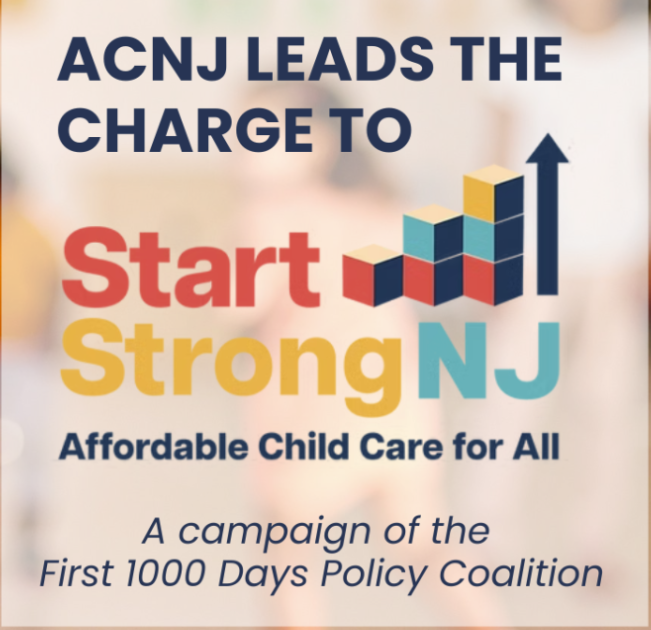Contact: Lana Lee, llee@acnj.org, 609-651-5855
Camden Kids Count 2025: Measuring Child Well-Being Amid Economic Pressures, Threats to Federal Safety Net Programs
Findings will be presented on Dec. 12th at education and advocacy symposium hosted by CPAC (Community Planning and Advocacy Council)
CAMDEN, N.J. — The City of Camden has made significant progress in reducing child poverty. However, economic pressures persist: 61% of households spend more than 30% of their income on rent, and the median family income remains well below what's needed to afford basic necessities. Meanwhile, roughly 13,500 children depend on federal programs like SNAP that face ongoing federal budget threats.
Of the roughly 19,600 children that call the city of Camden home, about two-thirds rely on SNAP and school lunch programs to support their nutritional needs. In 2025, 18,439 children under age 19 were enrolled in NJ FamilyCare, which is partially funded by Medicaid.
Read Camden Kids Count 2025
View Dec. 12th Event Flyer, where ACNJ will present findings at 9:15am
The first Camden-specific Kids Count child well-being data report published in over two decades by Advocates for Children of New Jersey (ACNJ), provides a comprehensive snapshot of how children are faring across nearly 100 indicators in areas including demographics, family economic security, child health, child protection, child care, education, and teens.
"The data tells a story of resilience and progress in Camden, but also reveals how vulnerable families remain," said Mary Coogan, President and CEO of ACNJ. "Although child poverty has decreased by 33% and median household income rose by 50%, families are struggling. The median income of $37,045 falls well below 200% of the federal poverty threshold, and 61% of households are spending dangerous shares of their income on rent. This is exactly why safety net programs are so critical—they’re helping families who are working hard but still can't make ends meet."
The report comes at a pivotal moment for Camden families. In 2024, 13,564 Camden children received SNAP benefits (formerly food stamps), 1,424 children lived in families receiving TANF (welfare), and thousands more depend on WIC, NJ FamilyCare, which is funded by Medicaid, and school meal programs. While a recent court order reinstated SNAP funding that had been threatened by federal cuts, other provisions in the federal budget reconciliation bill known as HR1—including Medicaid work requirements, increased state costs, and eligibility restrictions—continue to loom over families relying on these programs.
Camden Kids Count also reveals improvement in the city’s graduation rate, increasing to 66% in 2023-24, but the percentage remains far lower than the state rate of 91%, and this challenge is compounded by the fact that nearly half of all students are chronically absent.
Key Findings
Growing Diversity:
- In 2024, 35% of births were to foreign-born women, a 47% increase since 2019.
- An estimated 19,596 children call the city of Camden home. Of these children, 64% identify as Hispanic or Latino and 40% as Black or African American.
- Nearly half of Camden's population age 5 and older speaks a language other than English at home.
Economic Progress with Persistent Challenges:
- Child poverty fell from 11,053 children living in poverty in 2014-2018 to 7,386 in 2019-2023.
- Median family income increased 50%, rising to $37,045 in 2019-2023.
However, 61% of households spend 30% or more of their income on rent, and 35% spend half or more of their income on housing.
- The unemployment rate stands at 9%, significantly higher than the state average.
Safety Net Programs Remain Critical:
- In 2024, 13,564 Camden children received SNAP benefits and 1,424 children lived in families receiving TANF in 2024.
- Roughly 4,600 individuals are enrolled in WIC.
- Of the Camden City school district students who received free or reduced-price lunch, 70% participated in school breakfast.
Education:
- State-funded preschool enrollment in Camden City has decreased by 24% between the 2019-2020 and 2023-24 school year.
- Camden City school district's graduation rate increased to 66% in 2023-24, up from 59% in 2020-21, but still much lower than the state rate of 91%.
- 14% of Camden City school district students are multilingual learners, a percentage that continues to grow.
- However, chronic absenteeism remains a challenge, with nearly half of students missing more than 10% of school days.
Child Protection:
- Camden County saw an 8% decline in the number of children under NJ Child Protection and Permanency (CP&P) supervision between 2020 and 2024.
- At the city, county, and state level, reports of abuse and/or neglect increased by 17%, 27%, and 29% respectively.
- Black children remain over-reported and over-represented in the child protection system, accounting for 52% of abuse/neglect reports in the City of Camden despite only 5% of those reports being substantiated, and comprising 46% of out-of-home placements.
Maternal and Infant Health:
- Women receiving early prenatal care increased 10% between 2019 and 2024.
- Babies born with low birthweight decreased 18% between 2019 and 2024, though at 11.5%, Camden's rate still exceeds the state average of 7.8%.
This report, published with support of the Camden Community Planning & Advocacy Council (CPAC), not only provides critical data on children and families in Camden, but will help decision makers plan effectively and ensure funding is directed where it is needed most.
"For more than 30 years, CPAC has worked to advance social, racial, and economic justice so that individuals and families can thrive," said Anita Wemple, president and CEO of CPAC. "This report provides the data we need to understand and respond to the needs of resident children and their families.”
ACNJ encourages community members, policymakers, and advocates to use the report's findings to strengthen programs and policies that support Camden families. With a new governor and general assembly, and ongoing federal budget debates, the organization emphasizes the importance of ensuring children's needs remain at the center of policy decisions.
"We have data showing that when families receive support through programs like SNAP, WIC, and Medicaid, children thrive," Coogan said. "Camden's progress proves that investments in families work. Now is not the time to pull back on programs that are helping families climb out of poverty."
###
Advocates for Children of New Jersey is the trusted, independent voice putting children’s needs first for more than 45 years. Our work results in better laws and policies, more effective funding, and stronger services for children and families. And it means that more children are given the chance to grow up safe, healthy, and educated.


 In order to give all children a strong and equitable start in life, New Jersey must begin with an intentional focus on eliminating racial inequities and disparities in access to essential supports, according to a new report,
In order to give all children a strong and equitable start in life, New Jersey must begin with an intentional focus on eliminating racial inequities and disparities in access to essential supports, according to a new report, 





